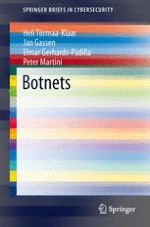2013 | OriginalPaper | Chapter
Botnets: How to Fight the Ever-Growing Threat on a Technical Level
Authors : Heli Tiirmaa-Klaar, Jan Gassen, Elmar Gerhards-Padilla, Peter Martini
Published in: Botnets
Publisher: Springer London
Activate our intelligent search to find suitable subject content or patents.
Select sections of text to find matching patents with Artificial Intelligence. powered by
Select sections of text to find additional relevant content using AI-assisted search. powered by
